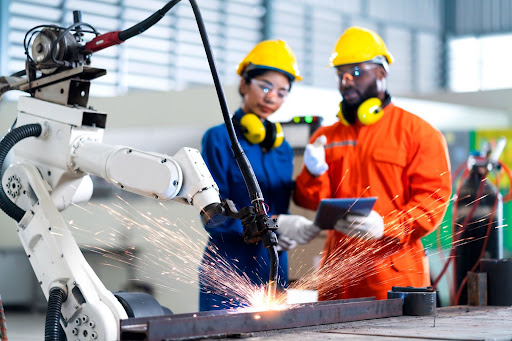AI to Ensure Safety Compliance in Manufacturing

Manufacturing environments can be hazardous with heavy machinery, sharp tools, and potentially dangerous materials. Ensuring the safety of workers is of paramount importance, and compliance with safety regulations is a top priority. With the advancements in artificial intelligence (AI) and computer vision, manufacturers are now leveraging these technologies to enhance safety measures. Come let’s explore how AI is being used to enforce safety compliance in manufacturing settings.
Real-time Monitoring of PPE
Personal Protective Equipment (PPE) such as helmets, safety goggles, gloves, and masks are essential in manufacturing. AI-powered cameras can continuously monitor the factory floor to ensure that workers are wearing the necessary PPE. If a worker is not properly equipped, the system can issue alerts, ensuring immediate compliance and reducing the risk of accidents.
Automated Safety Checks
AI systems can perform automated safety checks, ensuring that machinery and equipment are in proper working order. Any malfunctions can be detected in real-time, allowing for immediate maintenance and preventing potential accidents caused by equipment failures.
Hazardous Area Monitoring
Manufacturing facilities often have restricted hazardous areas that require special access or safety precautions. AI can be integrated with access control systems to grant or deny access based on safety compliance. Workers without the required safety gear may be denied entry, preventing unauthorised access to dangerous areas.
Behaviour Analysis
AI can analyse worker behaviour in real-time. It can identify unsafe actions or behaviours, such as workers not following safety protocols. For instance, if a worker is walking into a restricted area without proper authorization, the AI system can issue an alert, allowing for corrective action before an incident occurs.
Reporting and Analytics
AI systems can collect and analyse data over time to identify trends in safety compliance. This data can be used for safety audits, reporting to regulatory bodies, and improving safety training programs. It provides valuable insights into areas where safety measures may need enhancement..
Cost Savings
Implementing AI for safety compliance can result in cost savings over time. Fewer accidents mean reduced medical expenses, worker compensation claims, and potential fines for safety violations. Additionally, automation reduces the need for dedicated safety personnel, further lowering costs.
Continuous Improvement
AI systems continually learn and adapt. As manufacturing processes change or new safety regulations are introduced, AI can be updated to ensure ongoing compliance. This adaptability is crucial in an ever-evolving manufacturing environment.
Conclusion
AI is revolutionising safety compliance in manufacturing by providing real-time monitoring, automated safety checks, and behaviour analysis. By enforcing safety protocols and preventing accidents, manufacturers can protect their workers, reduce costs, and maintain compliance with safety regulations. As technology continues to advance, the integration of AI in manufacturing safety is likely to become even more effective and widespread. Embracing these innovations can lead to safer, more efficient manufacturing operations.

